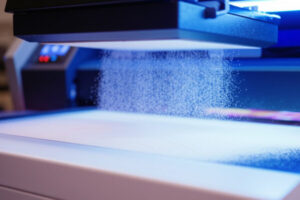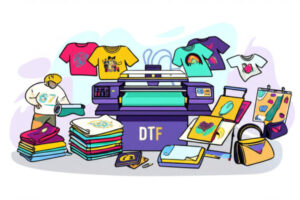Tired of tricky printing methods? DTF printing changes everything, making it easy. I found it transformative, and it’s now my go-to!
DTF printing uses film, ink, and adhesive powder to print designs, coat with powder, cure, and transfer them onto fabric, creating vibrant, durable results.

I stumbled upon DTF printing while seeking simpler solutions. Its ease kept me hooked. Let’s dive into the steps and see why it’s a hit.
How Does DTF Printing Begin with Film?
Ever wonder how designs start on fabric? I did, until DTF’s film method amazed me. It’s simple and sets the stage perfectly.
DTF starts by printing a design onto PET film using CMYK and white ink. The film holds the ink, creating a base for vivid designs.

Exploring the Film Stage
I begin with a digital design, crafted in basic software. The design prints onto a polyethylene terephthalate (PET) film, which is like a canvas for ink. The printer uses CMYK inks for colors and white ink for brightness, especially on dark fabrics. I was stunned by the sharp, clear designs on the film. The white ink layer makes colors stand out, no matter the fabric. This step is so easy that I mastered it fast. It’s perfect for beginners, and the film’s role is crucial for the next steps.
| Step | Details |
|---|---|
| Design Creation | Make artwork in simple software. |
| Film Printing | Print on PET film with CMYK + white ink. |
| Ink Role | White ink boosts color on any fabric. |
What Makes Adhesive Powder Essential in DTF?
Curious why DTF designs stick so well? I was confused until adhesive powder showed its power. It’s the secret to strong designs.
Adhesive powder coats the wet ink on the film, binding the design. It’s cured with heat, preparing it for fabric transfer.

Unpacking the Powder’s Role
After printing, I sprinkle adhesive powder over the wet ink on the film. The powder sticks to the design, and I shake off the extra. Then, I heat the film in a press or oven at 160°C for a few minutes. This melts the powder into a sticky layer that holds the design. I love how clean this step is compared to messy screen printing. The powder ensures the design bonds tightly to the fabric later. It’s a small but mighty part of DTF, making transfers reliable and durable.
| Component | Function |
|---|---|
| Adhesive Powder | Sticks to ink, binds design to fabric. |
| Heat Curing | Melts powder for a sticky bond. |
| Excess Removal | Keeps the design clean and precise. |
How Does DTF Transfer Designs to Fabric?
Struggled with design transfers? I failed often until DTF’s transfer step blew me away. It’s quick and nearly foolproof.
The cured film is heat-pressed onto fabric at 160°C for 10-15 seconds, transferring the design. The film is then peeled off.

Mastering the Transfer Process
I place the cured film on the fabric, design facing down. Using a heat press, I apply heat and pressure for 10-15 seconds. The adhesive powder melts, sticking the ink to the fabric. After a brief cool-down, I peel off the film, revealing a bright design. I was thrilled at how it worked on cotton, polyester, and blends. Unlike DTG, DTF skips fabric prep, saving me time. The process is so smooth that I felt confident after one try. It’s perfect for creating durable, vivid prints.
| Action | Outcome |
|---|---|
| Heat Pressing | Melts powder to bond design to fabric. |
| Film Peeling | Leaves a vibrant, lasting design. |
| Fabric Flexibility | Works on cotton, polyester, and blends. |
Why Has DTF Printing Taken Off?
Wonder why DTF is everywhere? I doubted its hype until I tried it. Its ease and versatility won me over completely.
DTF printing is popular for its simple process, wide fabric compatibility, and vibrant, durable designs, making it ideal for beginners and businesses.

Why DTF Stands Out
DTF’s rise is no accident. I found it fixes flaws in older methods. Screen printing needs complex setups, but DTF is straightforward. DTG requires fabric prep, while DTF works on almost anything—cotton, polyester, even leather. The designs are stretchy, vivid, and long-lasting, perfect for custom shirts. I started using DTF for my small business, and the low cost was a huge plus. I trained my team in hours, thanks to the simple steps. Its ability to produce high-quality prints with minimal effort makes DTF a favorite for hobbyists and pros alike.
| Feature | Benefit |
|---|---|
| No Fabric Prep | Saves time and simplifies the process. |
| Broad Compatibility | Prints on many materials, including blends. |
| Easy Setup | Great for beginners and small businesses. |
Conclusion
DTF printing is easy, versatile, and produces stunning designs. It transformed my printing game, offering a simple, effective process for vibrant results.

